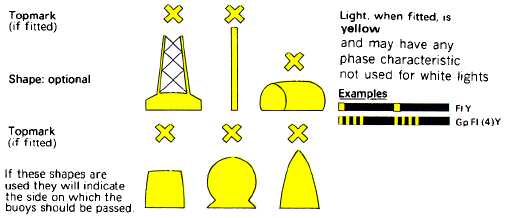| |
C69.225
Yellow is the color used for special marks. The
shape of a special mark is optional, but it must not
conflict with a lateral or a safe water mark. For example,
an outfall buoy on the port-hand side of a channel could
be can shaped but not conical.
When a topmark is carried, it takes the form of a
single yellow X. When a light is exhibited, it is yellow.
The phase characteristics may be any, other than those
used for the white lights of cardinal, isolated danger, and
safe water marks.
Daymarks
Unlighted aids to navigation (except unlighted
buoys) are called daymarks (fig. 5-33). A daymark may
consist of a single piling with a mark on top, a spar
supporting a cask, a slate or masonry tower, or any of
several structures.
Daymarks, like lighthouses, are usually colored to
distinguish them from their surroundings and make
them easy to identify. Daymarks marking channels are
colored and numbered like channel buoys. Many are
fitted with reflectors that show the same colors that a
lighted buoy would show at night in the same position.
Intracoastal Waterway
The Intracoastal Waterway, called the inland
waterway, is a channel in which a light-draft vessel can
navigate coastwise from the Chesapeake Bay almost to
the Mexican border, remaining inside the natural or
artificial breakwaters for almost the entire length of the
trip.
Every buoy, daymark, or light structure along the
Intracoastal Waterway has part of its surface painted
When steering on a range, it is highly important that
you ascertain the limit beyond which the range line of
5-35
Figure 5-32.— IALA Maritime Buoyage System special marks.
yellow, the distinctive coloring adopted for this
waterway. Somewhere on a lighted buoy is a band or a
border of yellow.
Red buoys and daymarks are to the right, green to
the left, as you proceed from the Chesapeake Bay
toward Mexico. As in other channels, red buoys have
even numbers; green buoys, odd numbers. Because the
numbers would increase excessively in such a long line
of buoys, they are numbered in groups that usually
contain no more than 200 buoys. At certain natural
dividing points, numbering begins again at 1.
Lights on buoys in the Intracoastal Waterway follow
the standard system of red lights on red buoys and green
lights on green buoys. Lights on other lighted aids agree
with the standard rules for lights on aids to navigation.
Ranges
Two day beacons, located some distance apart on a
specific true bearing, constitute a day beacon range.
When a ship reaches a position where the two lights (or
beacons) are seen exactly in line, it is “on the range.”
Ranges are especially valuable for guiding ships along
the approaches to or through narrow channels. Much of
the steering through the Panama Canal is accomplished
on ranges. Other examples of successive straight
reaches marked by ranges are the channel entrances to
the St. Johns River (on the Atlantic coast) and the
Columbia River (on the Pacific coast).
Lights on ranges may show any of the four standard
colors, and they may be fixed, flashing, or occulting.
Most range lights appear to lose intensity rapidly as a
ship diverges from the range line of bearing.
|

